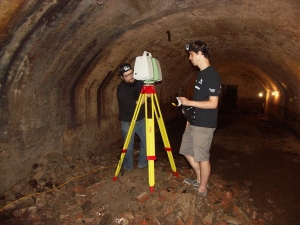Exploring Unseen Iowa City
July 18, 2016

A team of researchers and students recently took LiDAR scans of Iowa City’s “beer caves.”
Beneath downtown Iowa City’s Brewery Square lies a network of man-made tunnels and caves that dates from the city’s earliest days. Most of us will never get the chance to go down in these caves, and many of us would never want to!
But now, thanks to sophisticated laser imaging (LiDAR) data gathered by an interdisciplinary team of University of Iowa scientists and researchers, we can experience subterranean Iowa City through online virtual reality.
IIHR Research Assistant Michelle Wienhold holds a PhD in archaeology and a master’s degree in Geographic Information Systems (GIS) in archaeology. She serves as GIS analyst for the Iowa Floodplain Mapping Project, an effort being conducted by the Iowa Flood Center and the Iowa Department of Natural Resources. Wienhold is also the group lead for the University of Iowa GIS Users Group. She was part of the team that recently took LiDAR scans of Iowa City’s “beer caves.”
In the 1850s, the Union Brewery constructed a series of beer caves about 30 feet below Linn and Market streets on Iowa City’s north side. The beer caves are enormous underground barrel-vaulted masonry cellars for beer storage and aging. Although the beer caves are now more than a century old, they continue to be structurally sound. Skilled artisans, many of them European immigrants, constructed the caves in the tradition of similar Roman-style beer caves.
According to Wienhold, this is the perfect site to achieve the LiDAR scanning project’s primary research goal: public education. The popularity of small local breweries today helps people connect with this chapter in Iowa City history and the breweries that used to thrive in this community. “People like beer,” she says. This fall, Wienhold says, the group will host a public event downtown for people interested in learning about (but not physically visiting) the beer caves. A professor from the classics department will discuss Roman brewing practices. “We’ll teach the public about what’s underneath Iowa City,” Wienhold says. In addition, a publicly available online video provides a virtual tour of the beer caves (insert URL).

The Iowa Flood Center’s Michelle Wienhold is also the group lead for the University of Iowa GIS Users Group. She was part of the team that recently took LiDAR scans of Iowa City’s “beer caves.”
Wienhold’s friend and colleague Adam Skibbe from the Department of Geographical and Sustainability Sciences invited her to join in the LiDAR exploration of Iowa City’s beer caves. The team included researchers, faculty, staff, and students from a number of University of Iowa departments, each with a different research focus. These included history (history of brewing), classics (Roman architecture), archaeology (excavations and how old and new caves were connected), geography (using LiDAR to understand and map the physical world), the Office of the State Archaeologist (Iowa City history), and more.

IHR Research Assistant Michelle Wienhold is group lead for the University of Iowa GIS Users Group. She was part of the team that recently took LiDAR scans of Iowa City’s “beer caves.”
Another benefit of the project is the opportunity to train graduate students on the use of advanced LiDAR. The technology is a boon for sensitive archaeological sites, including the rock art and cave paintings that are Wienhold’s research focus. “Those are very fragile, and they’re also very sacred sites,” Wienhold explains. “The trend in archaeology these days is to be as non-intrusive as possible without disturbing the sites.” By using LiDAR scanning technology, many more people can experience the cave paintings without ever stepping foot in a cave.
For a lover of rock art and cave paintings like Wienhold, one of the highlights of her day in the beer caves came with the discovery of decades-old graffiti, including a quote from Dante’s Inferno: “The quote was, ‘Abandon all hope, ye who enter here.’ Quite appropriate I think!” Wienhold says.
Check out this fly-through video of the caves created with the LiDAR scans.



